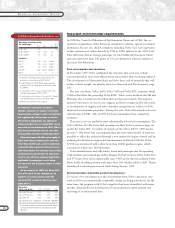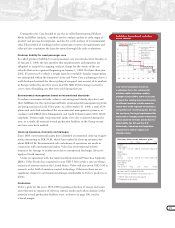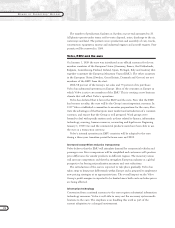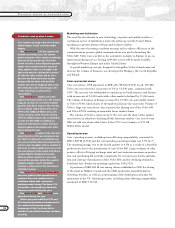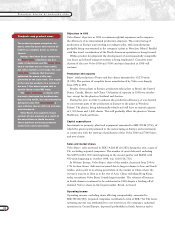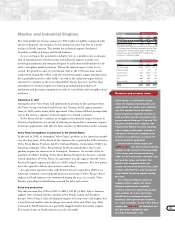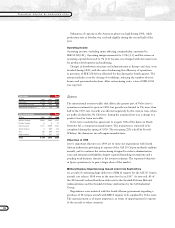Volvo 1998 Annual Report Download - page 31
Download and view the complete annual report
Please find page 31 of the 1998 Volvo annual report below. You can navigate through the pages in the report by either clicking on the pages listed below, or by using the keyword search tool below to find specific information within the annual report.
29
Total market development trucks ³ 16 tons
Number of new trucks, registered, thousands
98
969594
100
200
300
400
500
700
600
Western Europe
North America
Japan
Other
665
171
205
53
236
97
665
207
236
32
190
Total
SEK M 1996 1997 1998
Net sales 44,275 50,840 63,837
Operating income1878 1,812 3,061
Operating margin, %12.0 3.6 4.8
1 Excluding items affecting comparability during
1998. Including items affecting comparability of
SEK 46 M, operating income amounted to SEK
3,015 M and operating margin to 4.7%.
Key ratios Trucks
1996 1997 1998
Western Europe 32,310 31,040 37,810
Eastern Europe 2,660 3,430 4,540
North America 16,850 20,900 29,310
South America 4,980 6,970 6,020
Asia 4,850 4,710 3,760
Other countries 2,030 1,930 1,840
Total 63,680 68,980 83,280
Volvo heavy trucks Market share,
registrations %
1997 1998 1997 1998
United States 17,290 24,060 9.7 11.5
Great Britain 4,420 5,600 16.7 18.3
France 4,130 5,590 13.5 14.5
Brazil 4,510 4,090 23.3 23.1
Germany 3,090 3,880 7.5 7.7
Number of vehicles invoiced Trucks
Largest markets Trucks
Trucks
Global demand for trucks leveled off at an historically high level in 1998. Large
increases in demand in Western Europe and North America compensated for
declines in Asia, Eastern Europe and South America and the total world market
for heavy trucks in 1998 was unchanged from the preceding year. The Western
European market for heavy trucks, which was characterized by severe compe-
tition, amounted to a record level of 207,000 vehicles (171,000). Demand was
also strong in the North American market, which amounted to 236,000 trucks
(205,000) in the heavy class. A certain softening of demand was noted in certain
parts of Western Europe in January and February 1999, but the level of demand
in North America remained high.
Competitors
Volvo is the world’s third-largest manufacturer of heavy trucks with total
weights of more than 16 tons. Sales are carried out in more than 100 countries
on all continents. There are eight competitors with annual production of more
than 30,000 heavy trucks; of these, Mercedes and the American company Paccar
are larger than Volvo. During 1998, Volvo was the second-largest make of heavy
trucks in Europe, while it ranked fifth in North America. Volvo is the sixth-
largest producer of trucks in the medium-weight class, 7 to 16 tons, in Europe.
Objectives in 1999
Volvo Trucks’ objective in 1999 is among others to establish a common product
base on all continents, which will involve building a larger number of models for
more markets, using the same modular concept.
The introduction of the FM family of trucks that was launched in 1998 will
also continue. As a result of the FM family’s increased competitiveness in the
construction and regional distribution sectors Volvo is creating prospects to
obtain larger shares of the market in the heavy-truck segment, notably in
Europe.
In addition, Trucks’ ambitions for 1999 include improved productivity,
increased distribution efficency as well as reducing product costs and the costs
for purchased materials. Moreover, aggressive efforts are being made in market
business and product development.
Greater economies of scale create conditions for consistent profitability
The trend towards increased economies of scale in Trucks, through products
based on the global modular concept and use of a maximum number of common
components, continued in 1998 with the launch of the FM family. 78% of the
Volvo FM’s components are the same as those used in the Volvo FH series,
which constitutes the base of the modular concept.
Further gains from coordinating operations with those of Volvo’s other
business areas represent another step towards greater economies of scale. The
new D7C engine, modified versions of which are also being used in Volvo buses,
is a concrete example of this.



